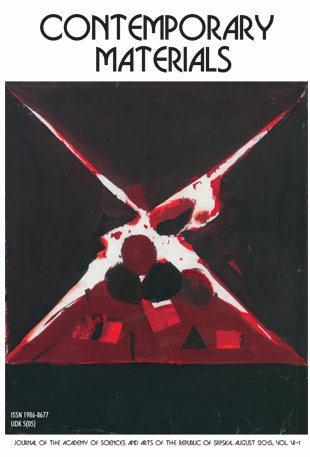MAGNETORESISTIVE RANDOM ACCESS MEMORY
DOI:
https://doi.org/10.7251/COMEN1702196OAbstract
For decades, the memory hierarchy was determined based on latency, bandwidth, and cost between processors, random access memory (RAM), and secondary memory. Although the gap between the processor and RAM has been dampened by fast cache memory, the gap between RAM and secondary memory has remained challenging, expanding to 12 size range in 2015 and continuing to expand by around 50% per year. The rapid development of nanotechnology has triggered a new field in the organization of memory space. For more than a decade, FRAM - ferro random access memory has been in use, which keeps data in the form of a polarization of the ferroelectric crystal that does not lose polarization after the power is turned off. The real revolution is expected in the use of magnetic resonance random access memory (MRAM), which represents data storage technology using magnetic moments, not electric charges. Unlike conventional RAM chips, data in MRAM are not stored as an electrical charge, but with magnetic storage elements. The advantage of this memory is energy independence, that is, the storage of recorded data and the absence of power supply. MRAM has similar properties as SRAM, similar to the density of the record as dynamic RAM (DRAM), with much less consumption, and in relation to flash, it is much faster and with time does not degrade its performance. Theoretically, there is no limit to the number of read and write, so new memories could last unlimited. The paper will discuss this new type of memory organization.
References
I. L. Prejbeanu, M Kerekes, Ricardo C. Sousa, J P Nozì Eres, Thermally assisted MRAM, Journal of Physics Condensed Matter, Vol. 19−16 (2007) 26.
W. Reohr, H. Hoenigschmid, R. Robertazzi, D. Gogl, F. Pesavenot, S. Lammers, K. Lewis, C. Arndt, Y. Lu, H. Viehmann, R. Scheuerlein, L.K. Wang, P. Trouilloud, S.Parkin, W. Gallagher, and G. Mueller, Memories of Tomorrow, IEEE Circuits &Devices, Vol. 18 (2002) 17–27.
B. Dieny, R. B. Goldfarb, K. J. Lee, Introduction to Magnetic Random-Access Memory, John Wiley & Sons, Book Chapter 6, NY USA (2016), 165−188.
J. M. Slaughter, R. W. Dave, M. De Herrera, M. Durlam, B. N. Engel, J. Janesky, N. D. Rizzo, S. Tehrani, Fundamentals of MRAM Technology, J. Superconductivity: Incorporating Novel Magnetism, Vol. 15 (2002) 19−25.
S. Yu, P. Y. Chen, Emerging Memory Technologies: Recent Trends and Prospects, IEEE Solid-State Circuits Magazine,Vol. 8−2 (2016) 43–56.
M. D. Stiles, J. Miltat, Spin Transfer Torque and Dynamics, in Spin Dynamics in Confined Magnetic Structures, III: Topics in Applied Physics 101, eds. B. Hillebrands and A. Thiaville, Berlin: Springer, 2006, 225−308.
G. D. Fuchs et al., Spin Transfer Effects in Nanoscale Magnetic Tunnel Junctions, Applied Physics Letters, Volume 85, Issue 7, NY 11747−4300, USA, (2004).
Jagan Singh Meena, Simon Min Sze, Umesh Chand and Tseung-Yuen Tseng, Overview of emerging nonvolatile memory Technologies, Nanoscale Research Letters, SpringerOpen Journal, Vol. 9−526 (2014) 1−33.
P. Le Clair, J .T. Kohlhepp, H. J. M. Swagten, W. J. M. de Jonge, Interfacial density of states in magnetic tunnel junctions, Phys. Rev. Lett., Vol. 86 (2001) 1066–1069.
J. L. Griffen, S. W. Schlosser, G. R. Ganger, D. F. Nagle, Operating System Management of MEMS-based Storage Devices, Carnegie Mellon University, Research Showcase @ CMU, Pittsburgh, PA, USA, 2000.
S. A.Wolf, D. Treger, A. Chtchelkanova, Spintronics: The Future of Data Storage?, Mrs Bulletin, Vol. 31 (2006) 400−403
H. A. Engel, L. P. Kouwenhoven, D. Lossand, C. M. Marcus, Controlling Spin Qubits in Quantum Dots, Quantum Information Processing, Vol. 3/1–5(2004).
High-Reliability Read-Method for Spin-Torque-Transfer MRAM, Next-Generation Non-Volatile Memory, Phys.Org, February 12, Fujitsu, 2010.
V. Khvalkovskiy, D. Apalkov, S. Watts, R. Chepulskii, R. S. Beach, A. Ong, X. Tang, A. Driskill-Smith, W. H. Butler, P. B. Visscher, D. Lottis, E. Chen, V. Nikitin, M. Krounbi, Basics principles of the STT - MRAM cell operation in memory arrays, Journal of Physics D: Applied Physics, Vol. 46−7 (2013) 139601.
J. Daughton, Magnetoresistive Random Access Memory (MRAM), Thin Solid Films, Vol. 216 (1992) 162−168.
N. D'Souza, J. Atulasimha, S. Bandyopadhyay, Four-state nanomagnetic logic using multiferroics, Journal of Physics D: Applied Physics, Volume 44−26 (2011) 265001.
L. Jiang, W. Wen, D. Wang, L. Duan, Improving read performance of stt-mram based main memories through smash read and flexible read, 21st Asia and South Pacific Design Automation Conference (ASP-DAC), Vol 1 (2016) 31–36.
H. J. M. Swagten, Spin tunneling in magnetic junctions, In: Buschow K H J (ed.) Handbook of Magnetic Materials, Elsevier, Vol. 17, Chap. 1 (2007) 1–121.
W. J. Gallagher, S. S. P. Parkin, Deve-lopment of the magnetic tunnel junction MRAM at IBM: From first junctions to a 16-Mb MRAM demonstrator chip, IBM J.Res. & Dev., Vol. 50 (2006) 5−23.
